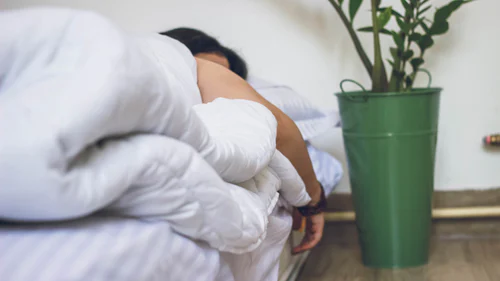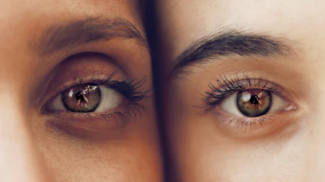Bags Under Your Eyes
From lack of sleep, a salty meal, ageing and even stress, having bags under our eyes is something we all experience. Whilst many of us are looking at ways to reduce them, it’s important to understand the science behind them, why they occur and how we can lessen them.
Roshni Patel, BSC (Hons) MCOptom reveals the truth behind bags under our eyes, the causes of them and some advice on how to help reduce them.
What are bags under the eyes?
Bags under the eyes are commonly associated with a lack of sleep, and appear as mild swelling or puffiness under the eyes, primarily as a result of fluid accumulation. They are predominantly a cosmetic concern and rarely ever are a sign of a serious medical condition.
What causes eye bags?
Eye bags can result from a wide variety of different causes, though the most recognisable and familiar is a lack of sleep.
It’s also very common as part of ageing: as we grow older, the tissues around the eyes weaken. With that weakening, normal fat that usually helps support the eyes falls into the lower eyelids, resulting in a puffier look, and fluid may accumulate in the new space, which adds to the appearance of puffiness.
But there are also lots of other reasons why you might have bags under your eyes, which include:
- Fluid retention - this can often occur after a salty meal, which causes greater fluid retention in the body
- Allergies
- Smoking
- A hereditary condition
- Sun exposure
- Eczema
Medical conditions related to bags under the eyes
Bags under the eyes are almost always harmless and rarely a result of anything more significant than a lack of sleep or other short-term factors, but there are some rare cases which may be a cause.
While not at all common, it’s possible that eye bags may be a result of thyroid or kidney problems or adrenal deficiency. Additionally, some medications, particularly stimulants or long-term use of painkillers that cause adrenal fatigue, can also result in bags under the eyes.
If you are concerned about bags under your eyes, for example if they’re painful or uncomfortable and if they persist for an unusual amount of time, consult your optometrist.

Bags under your eyes and contact lenses
Bags under eyes are usually a cosmetic concern, and rarely a sign of a serious underlying medical condition. Unless they’re painful, there should be no issue wearing contact lenses while you have bags under your eyes.
If you experience discomfort putting your lenses in, however, or if they don’t sit comfortably while in your eyes, you should remove them as soon as possible.
How to get rid of bags under the eyes
Eye bags usually either result from temporary factors, and thus will pass on their own, or are a symptom of ageing and muscles weakening over time, in which case they may be unavoidable to some extent.
However, there are some ways you can tackle common causes behind eye bags to reduce their appearance. And for persistent puffiness, it may be possible to get eyelid surgery.
Roshni Patel, BSC (Hons) MCOptom comments on some at-home remedies you may wish to consider:
Longer and more consistent sleep: lack of rest is the most common reason for eye bags, but sleeping efficiently with regular hours can contribute to a healthier lifestyle in general.

- Use antihistamines: allergies can sometimes result in puffy eyes. By taking antihistamines, you can reduce the effects of the allergy, including puffiness.
- Reduce stress: stress can lead to worse sleep and puffy eyes. Dealing with it with options like exercise and lifestyle decisions can help protect your mental health, and reduce the toll on your body.
Eat less salt and have more iron-rich food: salt encourages fluid retention in the body and can result in fluid build-up under the eyes. A reduction in salt intake may assist with reducing puffiness. For those that struggle with anemia, eating iron-rich foods may also help to reduce symptoms as they allow the increase of oxygen to reach the tissues in your body and avoid the appearance of dark circles.

- Remember to take your makeup off before bed: After a long day, it’s important to wash your face and remove all makeup before going to sleep. Leaving eye makeup on overnight can irritate your eyes and as a result can increase your chances of infection which can make your eyes become red and puffy.
- Cold or caffeinated compress: caffeine and cold can both help to lessen the appearance of bags under the eyes. A cool green tea bag applied under the eyes may reduce puffiness.
- Reduce your alcohol intake: Dehydration can lead to dark circles under your eyes and bags, so cutting out or reducing your intake of alcohol which contributes to dehydration may help relieve this appearance.
Use sun cream: sun exposure can accelerate the effects of ageing and ultimately lead to bags under the eyes as the tissues weaken. Use sun cream to protect your body from UV rays.

Include retinol cream in your everyday skin routine - Retinal is a cream that’s been used to tackle acne, aging, psoriasis and even certain cancers, and is an ingredient that is related to vitamin A. Retinal can help tackle eye bags as when applied to the skin it can improve collagen deficiency. It is typically applied as a cream gel or liquid form and is applied once a day.

- Stay hydrated - dehydration can be a significant factor to experiencing under-eye bags. It’s important we are keeping our water levels replenished each day, with experts recommending drinking around 13 cups of fluids a day for men and 9 for women.



